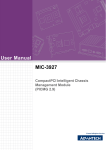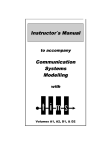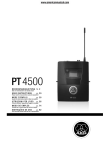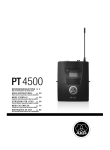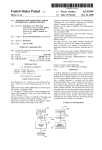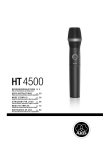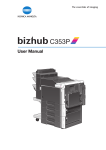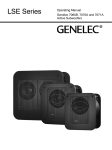Download AKG WMS 400 User`s manual
Transcript
AKG WMS SR 400 UHF AKG WMS 400 RECEIVER THE FIRST STEP TO PROFESSIONAL MULTICHANNEL TECHNOLOGY The SR 400 diversity receiver is an optimal System, you can set up even complex wireless solution if you need a reasonably-priced, high- systems using antenna splitters, power supply units and a whole range of high-performance performance multichannel system. external antennas. Based on the technology and experience of the revolutionary WMS 4000 wireless system, the It has never been easier to set up a professional SR 400 offers countless features that make wireless system in this price bracket than with the WMS 400 system. In Auto Setup mode, the setup and operation easier than ever before. receiver automatically scans the RF environWith simultaneous operation of up to 12 chan- ment in the available frequency bands, finds an nels on each frequency band, you can be cer- interference-free channel, and is able to transtain of smooth operation even in tricky situa- mit this preset to the associated transmitter by tions in critical RF environments. Thanks to its infrared. This makes it possible to set up a mulcompatibility with the professional WMS 4000 tichannel system in just a couple of minutes. Increased operational reliability and user convenience are ensured especially by the rehearsal function (complete RF testing of all components), clear display of all parameters on a programmable display, an easily visible warning signal with two-color display backlighting, and a low-battery warning on the receiver. Housed in a rugged half-rack metal case with a host of innovative features, the SR 400 receiver offers all the benefits to make this a top-quality wireless system for both the upcoming star and the price-conscious professional. Backlit LC display Gives you a function check at a glance, with two-color backlighting (red/green). Status LEDs Provide detailed information about the most important system parameters, such as audio level, diversity status, RF level, etc. SR 400 Receiver On/Off switch Recessed level control Allows you to adjust the output level, recessed to prevent accidental readjustment. Infrared interface for transmitter programming Fast and reliable transmission of frequency settings to prevent misprogramming. Display Details ➊ Menu buttons Facilitate easy programming. ➑ ➊ 7-level audio bargraph display Display Details ➎ Special functions: receiver name, status display, squelch threshold, system info, etc. ➋ Frequency setup menu with three operating modes: Auto Group, Auto Channel, Preset ➏ Lock mode ➌ Infrared transmission mode ➐ Squelch threshold adjustment mode ➍ Rehearsal function: Rapid check of RF & audio signal quality ➑ 7-level RF bargraph display and diversity LEDs ➋ ➌ ➍ ➎ * The maximum number of channels may vary according to local frequency plans. 28 Metal case Half-rack width for convenient rack installation. www.akg.com ➏ ➐ AKG WMS SR 400 UHF Auto setup The receiver is automatically searching for clean frequencies, making system programming quick and easy. Infrared transmission The receiver is downloading frequency setup data to the transmitter. Each Preset contains legal frequencies for a specific country, region, or state Integrated frequency management database with country coded sets of frequencies for easy frequency selection. Rehearsal mode The receiver is recording dropouts and related parameters as the transmitter is moved about the performance area. XLR audio output Professional balanced XLR output connector. Antenna input socket Allow you to connect plug-in antennas, remote antennas, or even a complex antenna network. System status If, for instance, the transmitter batteries are running low, the display backlighting will change to red, reminding you that the system needs your attention. Lockable DC input Ensures reliable connection to the power supply, with a lock to prevent accidental disconnection. Audio output jack Professional unbalanced output jack. Range of accessories for complex applications Thanks to its compatibility with the WMS 4000 wireless system, there is a wide range of accessories available for setting up complex multichannel systems. These include the PS 4000 antenna splitter, the PSU 4000 power supply unit, active and passive antennas with a variety of polar patterns, antenna boosters and remote power supplies, and the HPA 40 headphone amplifier. WMS 4000 Series transmitters also work perfectly with an SR 400. www.akg.com 29 AKG WMS HT 400 UHF AKG WMS 400 TRANSMITTERS HANDHELD AND BODYPACK TRANSMITTERS FOR EVERY CONCEIVABLE APPLICATION remaining battery life, low battery warning, microphone element. A noiseless On/Mute/ Off switch and status LED provide additional and current transmission mode. user convenience. Once you have set a frequency on the receiver, an infrared transmission link will feed The PT 400 bodypack transmitter has a rugthe related data to the assigned transmitter ged metal case with a mini XLR socket that within seconds, making the setting up of allows you to connect a wide variety of microphones and instruments. It also has a jack for large multichannel systems child's play. connecting an external mute switch – a parAn LC display provides information at a glance about important parameters such as The HT 400 handheld transmitter is avail- ticularly useful feature when the transmitter frequency/Preset name (country code), able with either a dynamic or a condenser is inaccessible. The HT 400 handheld and the PT 400 bodypack are high-performance, compact wireless transmitters that can be used for every conceivable application. Many innovative features not only ensure greater reliability of operation, but also provide extremely convenient operation. HT 400 Handheld transmitter Extremely rugged spring steel mesh grill Protects the microphone capsule underneath in tough stage acts and live performances. Infrared sensor Makes child’s play of transmitter programming by downloading frequency and gain settings from the receiver via infrared. Display Shows the selected frequency/ preset and remaining battery life. On-Mute/Program-Off switch A recessed mode switch prevents accidental mode switching. Soft-touch enamel finish Adds to handling noise rejection. Charging contacts Convenient plug-in charging on the CU 400 charger is environmentally friendly and saves money. PPC 1000 Polar Pattern Converter 30 Interchangeable, color code strips you can write on For convenient transmitter identification on multichannel systems. Battery compartment The transmitter can be powered by a single AA size dry or rechargeable battery. PPC 1000 and PB 1000 for the C 900 You can quickly change the polar pattern of the C 900 from cardioid to hypercardioid by attaching the supplied PPC 1000 Polar Pattern Converter (left) to the capsule. Also supplied with the C 900, the PB 1000 Presence Boost Adapter (right) provides a 3 to 5 dB presence rise between 5 kHz and 9 kHz for better intelligibility and a more sparkling instrument sound. www.akg.com PB 1000 Presence Boost Adapter AKG WMS PT 400 UHF Microphones for PT 400 C 411 L C 416 L C 417 L C 419 L C 420 L C 444 L CK 77 WR L CK 77 WR L/P CK 97-C/L MKG L CK 55 L C 477 WR L For hints on how to use MicroMic Series products refer to pages 70 and 71. PT 400 Portable transmitter Flexible Antenna Maximum transmission reliability. Rugged mini XLR connector Professional 3-pin mini XLR input for connecting MicroMic Series or other head-worn microphones, lavalier microphones, or instrument cables from AKG. Soft-touch finish Soft-touch enamel reduces handling noise. Infrared Sensor Setting up the transmitter is incredibly easy as frequency and gain data is downloaded from the receiver via infrared transmission. Input gain control Sets the gain of the audio input stage. Display Indicates the selected frequency or preset as well as the remaining battery capacity in hours. Detachable belt clip 0,1 ” jack for external mute switch An external mute switch allows the user to mute the signal even if the transmitter is hidden beneath clothes. Interchangeable color code labels For identifying multichannel system transmitters. Charging contacts Convenient plug-in charging on the CU 400 charger is cost efficient and friendly to the environment. Frequency is being downloaded from the receiver Battery compartment The transmitter can be powered by a single AA size dry or rechargeable battery. Frequency preset Frequency in MHz LCD display The LCD on the HT/PT 400 provides a clear readout of the most important transmitter parameters. As soon as the battery capacity drops to a critical level, a warning will appear in the display. Simultaneously, the receiver will display the same warning and change the display backlighting to red. Battery status display Low battery capacity warning www.akg.com 31 AKG WMS CU 400 THE AKG WMS 400 SERIES CHARGER THE USER FRIENDLY QUICK CHARGER time, it is still a good idea to use fresh dry or The CU 400 puts an end to this kind of hassle. It can charge two batteries simultaneously to fully charged rechargeable batteries. full capacity within less than two hours, and However, the setup phase and the soundcheck there is no risk of overcharging the batteries. already use up some of each transmitter battery's capacity, so the batteries need to be top- And what's more, you can leave the batteries ped up before the show. Obviously, there is not inside the transmitters. The transmitters and Although the battery status indicators and war- enough time to use a conventional charger, let charger use integrated charging contacts so all ning lights on the WMS 400 transmitters and alone take the transmitters apart to get at the you have to do is plug the transmitters into the CU 400 and remove them after charging. receiver alert you to a dying battery ahead of batteries inside their compartments. Any wireless microphone system depends on sufficiently charged batteries in all the transmitters. There is nothing more embarrassing than a transmitter running out of juice in the middle of the show, or a voice fading as the transmitter battery dies. 2 universal charging slots Accommodate HT 400 and PT 400 transmitters. CU 400 Charging unit Locking DC jack Input jack for a local or central power supply (e.g., PSU 4000). Charging status LEDs Integrated charging contacts for direct charging Both the HT 400 and the PT 400 provide integrated bottom panel charging contacts. To get the batteries fully charged in less than two hours, just plug the transmitters into the CU 400. A single CU 400 can charge two transmitters simultaneously, making it easy to restore even a large number of transmitters to maximum performance within a short time. 32 www.akg.com AKG WMS 400 ACCESSORIES SRA 1 – Passive wideband dirctional antenna • For indoor and outdoor use, specifically for setting up long-range radio links • For use with short antenna cables SRA 2B – Active wideband dirctional antenna • For indoor and outdoor use, in particular for setting up long radio links • Integrated high-performance antenna booster for use of long antenna cables • Remote powering option, status LED • Rugged water-resistant case with BNC output RA 4000 B – Omnidirectional wideband booster antenna • For indoor and outdoor use, in particular for near-field antenna setups with no preferred direction • Integrated high-performance antenna booster for use of long antenna cables • Remote powering option, status LED • Rugged water-resistant case with BNC output AB 4000 – Antenna booster • Ultralinear antenna booster with water-resistant case • BNC or N inputs and outputs, DC input, status LED • DIP switch for gain adjust HT 4000 • Wideband UHF handheld transmitter with interchangeable microphone elements and metal die-cast body • Preprogrammed factory presets • Up to 24 intermodulation-free frequency groups in each 30 MHz wide UHF band • Up to 15 hours continuous operation on 2 AA size alkaline batteries or a minimum of 12 hours on optional BP 4000 battery pack PT 4000 • UHF bodypack transmitter with magnesium body • 1200 selectable frequencies in 30 MHz band • Backlit display and jog switch operation • Up to 50 mW (ERP) output for reliable transmission • Optional remote mute switch • Operates for up to 15 hours on AA batteries, 12 hours on optional BP 4000 battery pack, and displays remaining battery life PS 4000 • Expandable modular antenna splitter with metal case • 220 MHz bandwidth for use with all WMS 4000 channels • Adjustable cable length compensation • For multi-room installation of antenna systems PSU 4000 Central power supply unit • Powers up to 12 SR 4000 receivers plus antennas via 3 PS 4000 antenna splitters, or three CU 4000 charging units • Also powers the HPA 4000 headphone amplifier or HUB 4000 network concentrator HPA 4000 Headphone amplifier • For connecting up to 8 SR 4000 receivers www.akg.com 33 AKG WMS MULTICHANNEL TECHNOLOGY SETTING UP MULTICHANNEL SYSTEMS HOW TO DEAL WITH INTERMODULATION AND KEEP YOUR FREQUENCIES STRAIGHT Whenever two or more signals are transmitted by a non-ideal system, undesired intermodulation products will be created, causing distortions (see also WMS 400, p. 31). An ideal system would deliver an output signal that is identical to the input signal over the whole frequency range even at larger amplitudes, and no problems would arise. In practice, however, ideal systems do not exist, as transistors in particular have only a relatively narrow linear gain range. This is why the transmission of several signals via nonlinear systems, such as transmitters and receivers, will result in unwanted arti- facts generated by intermodulation. These Whenever the frequency of the desired sigintermodulation products have to be dealt nal coincides with that of an intermodulation product the signal will be distorted. with somehow in practice. Moreover, the intermodulation product may The order of intermodulation products activate the receiver's squelch function if depends on the nonlinearity of the system the amplitude of the intermodulation freresponse curve; the amplitudes of intermo- quencies exceeds the squelch threshold. dulation products will always grow in proportion to the product of the mathematical Obviously, the effective impact of intermopowers of the fundamental signals genera- dulation distortion also depends on the ting a given intermodulation product. In distance between transmitter and receiving reality, third-order intermodulation pro- antenna. In the case of wireless microphoducts tend to be particularly troublesome nes transmitting on an intermodulation frebecause they rise much more rapidly than quency, the desired signal is often ruined by the fundamental signal, thus turning into intermodulation distortion if you move the transmitter too far away from the receiver. real, i.e., audible noise. Ideal and real gain curves of ideal and real amplifiers High audio input levels may overload the amplifier, so the peaks of the amplified signal are clipped as a result of saturation. The compression characteristic may be described by a polynomial (i.e., the sum of multiples of powers of a variable X). This polynomial includes all powers, with the odd powers (3, 5, 7, ...) responsible for intermodulation in multichannel systems. Because of its high coefficient, the third power term is especially important which is why third-order intermodulation products are dominant. The reciprocal value of the third-order coefficient defines the IP 3 Intercept (see below), which is the most important parameter for the intermodulation resistance of an RF amplifier. A smaller third-order coefficient of the transmission polynomial means a higher IP 3, which implies greater linearity of the RF amplifier and thus better resistance to intermodulation distortion. IP 3 Intercept The Intercept marks the intersection of the theoretical linear transfer curve for the wanted signal’s amplifier response curve and the theoretical linear transfer curve for the third-order intermodulation product. It is never actually reached because the amplifier will compress the wanted signal before it reaches the IP 3 Intercept level. The higher the Intercept of a radio transmission system, the lower the IM risk, and the more channels may be used within a given frequency band. 34 www.akg.com AKG WMS MULTICHANNEL TECHNOLOGY Microphone A carrier frequency Spectrum analyzer trace Intermodulation of carrier frequencies A and B The trace clearly shows that third-order intermodulation products are only 38 dB lower in level than the carrier frequencies. Microphone B carrier frequency Spectrum analyzer trace Intermodulation trace on a spectrum analyzer display Third-order intermodulation products from three carrier frequencies. The received signal level declines in proportion to the square of the distance between transmitter and receiver, and the intermodulation level produced in the receiver declines in proportion to the third power of the received signal level. This implies that intermodulation declines exponentially, in proportion to the sixth power of the distance between transmitter and receiver. If the distance is longer than 66 feet (20 m), receiver intermodulation is drowned out by noise. What remains is another important type of intermodulation distortion that has not yet been mentioned: transmitter intermodulation. In this case, the intermodulation products are not generated in the receiver, but in the transmitters, and are radiated by them along with the desired carrier frequencies. This will only happen, however, if there is enough crosstalk of carrier frequencies between two neighboring transmitters that intermodulate with each other. In this case, the antenna of one transmitter receives the carrier signal of a neighboring transmitter. If this signal makes it into the non-linear output stage of the transmitter, the first harmonic of the desired signal will transform it into a signal whose frequency is indistinguishable from the receiver intermodulation. The same happens in the other transmitter that will generate a mirror-image intermodulation product. Curiously, a love duet close to the receiving antennas may lead to intermodulation distortion caused by the nonlinear receiver. If the two singers move away, the Intermodulation trace on a spectrum analyzer display Intermodulation products from 2 carrier frequencies, 3rd-order IMD and 5th-order IMD. intermodulation remains unchanged, but is now produced in the transmitters. In large multichannel systems, reducing the RF output of the transmitters is a way to bring down transmitter intermodulation by minimizing the nonlinear response of the transmitter's output stage. The RF output of WMS 4000 transmitters, for example, can be reduced from 50 mW to 10 mW (ERP – Equivalent Radiated Power). Here are some hints on how to minimize receiver intermodulation: Always lay out the antenna system so as to ensure reliable transmission from every point on the stage. Moreover, be sure to use only the types of cables recommended in the user’s manual. The distance between transmitters and active antennas should be at least 15 feet (5 m) (see also Antenna Position Check Applet on p. 45). Increasing the input attenuation of the antenna system helps, as does reducing the transmitter RF output to 10 mW. The latter has proved particularly useful for hand-held transmitters in situations where range is not an important consideration; generally, the RF output level used should always be just high enough to ensure adequate transmission. Systems with a higher transmitter RF output (ERP) are more prone to intermodulation problems, but this is compensated for by their better resistance to electrosmog. When multichannel systems are used on Broadway, for instance, only the strongest will survive. www.akg.com 35 AKG WMS MULTICHANNEL TECHNOLOGY SETTING UP MULTICHANNEL SYSTEMS HOW TO DEAL WITH INTERMODULATION AND KEEP YOUR FREQUENCIES STRAIGHT Frequency Management: a good idea for any multichannel system One way to run a multichannel system would be to hire an RF engineer with a university degree for doing nothing but the number crunching required for finding clean frequencies and keeping an eye on all the batteries in the system. Unfortunately, it is not easy to find someone with this kind of knowledge, and then these experts are extremely busy and expensive. Don't worry, there is an easier way. WMS Series wireless systems from AKG provide both an integrated Frequency Management System and clear battery status readouts to remove the hassle from setting up and operating a multichannel system and save time and money. Calculation of intermodulation products fIM = | m1f1 + m2f2 + m3f3 + m4f4 + … | mv = 0, ±1, ±2, ±3, ±4, … The order of IM products depends on the non-linearity of the transfer characteristic. fIM = | 2 f1 ± f2 | , fIM = | f1 ± f2 ± f3 | 3rd order Derivation of 3rd order intermodulation products (cosω1t + cosω2t + cosω3t)3 = ( + 3 + 3 + 3 e jω t + e -jω t 1 1 2 ( ( ( e jω t + e -jω t 1 1 2 e jω t + e -jω t 2 2 2 e jω t + e -jω t 3 3 2 2 ) 2 ) 2 ) 2 2 2 e jω t + e -jω t 2 2 +3 2 e jω t + e -jω t 1 1 +3 2 e jω t + e -jω t 1 1 +3 2 ( ( ( 2 1 2 e jω t + e -jω t 2 2 2 e jω t + e -jω t 3 3 2 2 2 2 www.akg.com 3 3 1 e jω t + e -jω t 2 2 e jω t + e -jω t e jω t + e -jω t e jω t + e -jω t 1 Dual-tone products are obtained from lines 1 through 4, e.g., | fIM = 2f1 - f2 | Three-tone products are obtained from line 5, e.g., | fIM = f1 + f2 - f3| 36 3 )+( e jω t + e -jω t 1 + 6 e jω t + e -jω t 3 )+( 3 3 2 ) 2 ) 2 ) 3 ) e jω t + e -jω t 3 3 2 e jω t + e -jω t 3 3 2 e jω t + e -jω t 2 2 2 AKG WMS MULTICHANNEL TECHNOLOGY The far-near difference Unlike a hardwire microphone, even the best wireless system is susceptible to dropouts because the relative positions of persons and objects within the coverage area will change constantly during an event. At any moment, shadow loss and signal cancellation may coincide with intermodulation and sideband noise in such a way as to cause a dropout. The specified dropout probability under such conditions for the WMS 4000 is less than 0.1%. However, this low dropout probability can only be achieved inside a Faraday cage in which no other RF or digital equipment is used along with the WMS 4000. This is equivalent to a downtime of one third of a second per hour. Noticing such short interruptions is difficult even for an experienced tonmeister. As mentioned above, the dropout probability or immunity to interference depends primarily on the antenna positions. Finding the best antenna locations is always a balancing act. If the antenna is too far away from the stage the received signal will be too weak and drowned out by receiver self-noise and other unwanted disturbances during a deep fade. If you install the antenna too close to or even on the stage, however, the dreaded intermodulation whistles To ensure intermodulation-free multichannel operation, AKG programs sets of frequency presets into each WMS 4000 system. Each preset contains groups of frequencies that do not disturb one another by intermodulation. Depending on local frequency plans, up to 18 channels can be used simultaneously within each 30 MHz subband. "Enhancedsecurity presets" with 14 channels or less within the respective 30 MHz subbands are available for some countries. generated by the receivers and transmitters may become audible. Here is where the far-near difference comes in. It is the difference between the receiving antenna’s distance from the rearmost point on the stage where a transmitter will be used and the receiving antenna's distance from the front edge of the stage. The Applet http://www.akgfrequency.at/antennaposition/ allows you to compute optimum antenna positions from known far-near differences. Although all the frequencies of any preset are approved for use in the respective country, you are still required by law to obtain a permit from the local authorities before you can use the system. Adding channels by duplicating an existing frequency structure Here is a proven way to add clean frequencies: 1. Refer to the Theater Frequencies table below and start with a frequency group you are using on stage A, for instance, Band I with 18 subchannels. 2. Add to each frequency half the minimum channel spacing. (In this example, the minimum channel spacing for a group of 18 frequencies is 300 kHz, one half of that being 150 kHz.) The resulting group for use on stage B (Band I + 0.15 in the table below) has the same properties as the original group. Provided the two rooms are separated by a brick wall at least 8 inches (20 cm) thick, you can use the new frequency group you derived by adding 150 kHz without risking intermodulation distortion. By repeating this procedure for the other two frequency groups used on stage A, you will obtain the table shown below with 108 subchannels in Bands I, II, and V. Theater Frequencies 1 2 3 4 5 6 7 8 9 10 11 12 13 14 15 16 17 18 Band I 650.850 651.350 654.850 656.350 667.950 673.250 650.150 665.050 666.050 675.450 672.450 676.050 650.450 652.450 658.150 661.950 663.350 671.150 Stage A AT 1 preset frequencies Band III 720.700 721.200 724.700 726.200 737.800 743.100 720.000 734.900 735.900 745.300 742.300 745.900 720.300 722.300 728.000 731.800 733.200 741.000 Band V 790.900 791.400 794.900 796.400 808.000 813.300 790.200 805.100 806.100 815.500 812.500 816.100 790.500 792.500 798.200 802.000 803.400 811.200 www.akg.com Stage B AT 1 preset frequencies increased by 150 kHz (0.15 MHz) Band I + 0,15 Band III + 0,15 Band V + 0,15 651 720.85 791.05 651.5 721.35 791.55 655 724.85 795.05 656.5 726.35 796.55 668.1 737.95 808.15 673.4 743.25 813.45 650.3 720.15 790.35 665.2 735.05 805.25 666.2 736.05 806.25 675.6 745.45 815.65 672.6 742.45 812.65 676.2 746.05 816.25 650.6 720.45 790.65 652.6 722.45 792.65 658.3 728.15 798.35 662.1 731.95 802.15 663.5 733.35 803.55 671.3 741.15 811.35 37 AKG WMS MULTICHANNEL TECHNOLOGY SETTING UP MULTICHANNEL SYSTEMS MODULAR SOLUTIONS FOR PROFESSIONAL REQUIREMENTS Calculating intermodulation-free radio frequencies requires an enormous amount of computing power. AKG used up to 150 computers operating day and night to calculate new sets of carrier frequencies unless the computers were needed for other purposes. The results are available to all users of AKG wireless systems on the Internet at www.akg.com/frequencies. The Frequency Management Program available on the AKG homepage lets you check all the radio frequencies you are planning to use for compatibility, making it easy to set up an AKG multichannel system that works perfectly from the start. www.akgfrequency.at The AKG Frequency Management Program checks all the radio links you are planning to use for compatibility and potential intermodulation problems. To make sure your wireless system will operate smoothly, we recommend checking both the frequencies your system is going to use and the frequencies of local radio and TV stations, etc. with this program before setting up the system. Frequency bands Each of the six bands contains legal frequencies and presets for reliable, intermodulation-free operation. Special frequency versions within each band are available on request. An optional programmer allows AKG staff to program these frequencies either on location (one user preset) or at your local AKG Service Center (all presets). RF output (ERP) The HT 4000 and PT 4000 transmitters are available in three different RF output versions. Each transmitter is delivered with the maximum RF output (ERP) approved for the country or region where it will be used. The RF output of a transmitter can be changed, but this can only be done by AKG Vienna. BAND 1 650-680 MHz BAND 2 680-710 MHz BAND 3 720-750 MHz 10 mW ERP * BAND 4 760-790 MHz 20 mW ERP * BAND 5 790-820 MHz BAND 6 835-863 MHz 50 mW ERP * * ERP = Equivalent Radiated Power Multichannel example 1 Each frequency band is 30 MHz wide and comprises up to 18 intermodulation-free frequencies (depending on local frequency plans). If you need more than 18 frequencies, you can use several bands. Make sure to select bands with the widest possible frequency spacing between them. Multichannel example 2 Where local frequency plans limit the available frequency range to two bands, you can still set up a large multichannel system. Bands 1 and 2 together provide about 25 usable frequencies in this example. Again, use bands with the widest possible spacing between them! 38 BAND 1 BAND 3 BAND 5 + + = 54 channels** 18 channels 18 channels 18 channels BAND 1 + www.akg.com BAND 2 = approx. 25 channels** AKG WMS MULTICHANNEL TECHNOLOGY HOW TO USE ANTENNAS SELECTING, PLACING AND USING ANTENNAS Any radio system uses antennas to get a signal from one place to another. To ensure the best possible signal quality, it is imperative to select the optimum antennas for the system and place the antennas correctly. Reflections, shadow loss, or deep fades may weaken or even cancel the radio signal (dropout). If you obey a few simple rules for placing your antennas, transmitters, and receivers, your system will operate smoothly. Absorption by or reflections off metal grid structures, the audience, and the musicians on stage (see illustration below) will attenuate any radio signal. For best results, place the receiver near the stage but at least 5 feet (1.5 m) away from any metal beams, spotlights, lighting control consoles, computers, or other digital equipment. Make sure the transmitter will always be at least 21 feet (7 m) away from the receiver (see Antenna Position Check Applet on page 45). Since UHF signals propagate in a similar way to light, always keep a direct line of sight between the transmitter and receiver. Antennas, like microphones, have different polar patterns. Depending on the venue and type of system, you may need directional antennas, such as Yagi (cardioid to hypercardioid) or log periodic (shotgun) types, or omnidirectional antennas with no preferred direction. Directional antennas are usually the best bet where the transmitters will only be used within a relatively small area, e.g., on a stage. Directional antennas can be used to overcome long distances or reject unwanted signals from off-axis directions. This is why they are very popular for openair events. The greatest benefit of directional antennas – provided their gain is high enough – is that you can place them far enough from the stage that all transmitters appear to be at the same distance from the antenna. This prevents transmitters nearer to an antenna from generating intermodulation products that may interfere with the weaker signals from more distant transmitters. Use active omnidirectional antennas in rooms that are too small for directional antennas. We recommend mounting the two antennas vertically polarized and as high as possible above the performers. Select your antenna cables very carefully, too. The antenna cable must feed the output signal of a remote antenna to the receiver. Note that any antenna cable will attenuate the signal it carries (cable attenuation). Different types of cable have different amounts of attenuation so which type works best depends on the length of the cable run. So if you need very long antenna cables, go for a low-attenuation type even though it will be thicker and more expensive than high-attenuation cable. To compensate for the attenuation of long antenna cables, use either active antennas or in-line boosters. In many situations, though, you may be able to save on active antenna components by using the nexthigher (slightly more costly) grade of cable. Using the optimum type of antenna cable may be the key to a smoothly working wireless system and helps reduce the levels of cost, stress, and aggravation. Large open-air festivals are one example where antenna placement is of paramount importance because the transmitters are usually far away from the antennas, and more often than not there will be other radio links (radio or TV station O/B vans, etc.) to deal with as well. We recommend using directional antennas, and don't be a miser when it comes to buying antenna cable! The only way to maintain good signal quality over long cable runs is to use expensive, high quality antenna cable, e.g., a type with a foam dielectric. A booster such as the AKG AB 4000 can compensate for 17 dB of cable attenuation, allowing you to add another 200 feet (60 m) or so of RG 213 cable to your antenna line. For extremely long lines, you can even use two boosters in series. If you have to route the antenna cables through a cable duct that may be prone to RF interference, use double-shielded cable. Signal loss caused by the audience The human body reflects and weakens radio signals. One problem that has plagued cellular telephone systems is the absorption of microwaves by human body tissues. Similar to the reverberation time, the RF level in a room decreases as the room becomes more crowded and absorption increases. Even if there is a line of sight between the transmitter and receiver, the audience in between will weaken the RF signal because part of the RF energy hits the people and is absorbed by their body tissues. We therefore recommend placing the antennas so that the line of sight will be at least 3 1/2 feet (1 m) above the audience's heads to reduce this absorption effect. Penetration depth in human body tissues for 4.3 dB attenuation: Skin Fat Muscle Cartilage www.akg.com 4.3 mm 10.4 mm 2.8 mm 21.0 mm 39 AKG WMS 4000 OVERVIEW THE WMS 4000 MODULAR SYSTEM MODULAR SOLUTIONS FOR PROFESSIONAL REQUIREMENTS The WMS 4000 is probably the most innovative professional wireless system available today. It is based on intensive R&D and has been thoroughly tested under real-life conditions before being released for production. The objective of AKG’s design engineers was extremely ambitious. capacity in hours, gain setting, or intermodulation-free frequencies. The WMS 4000 transmitters provide a “Silent Mode” in which you can set all system parameters such as carrier frequency, gain, etc. without transmitting an RF signal. A “hidden” pilot tone in the 30 kHz range transmits battery status data to the receiver and allows autoTherefore, all competitive systems were matic muting of the receiver audio outputs tested for ease of use and real-life reliabili- in case of signal loss. ty. Users were then asked to make a wish list of additional functions. These sugges- The SR 4000 Stationary Receiver is a true tions were examined for feasibility. The result diversity receiver that ensures exceptional is the new WMS 4000 wireless microphone reliability. A 30 MHz wide UHF subband system that had stirred up speculations and allows many wireless microphones to be discussions within the audio community used simultaneously for smooth multichaneven before it was launched. The most stri- nel operation. An automatic frequency king detail of the new WMS 4000 Series is scanner and setup function quickly finds the advanced backlit display on both the the best intermodulation-free frequencies handheld and bodypack transmitters and from a bank of presets. The SR 4000 is the receiver. The display makes it easy to highly frequency agile to accommodate any check the selected preset and other impor- changes in frequency plans that may vary tant parameters including remaining battery from date to date and location to location. Unlike conventional wireless systems, the WMS 4000 components allow frequencies to be reprogrammed quickly and easily at any time. The CU/BP 4000 charging system is a true innovation. The SBMS Smart Battery Management System includes a number of intelligent monitoring functions. Inflection Point and Peak Voltage Detect stops the charging in time, while an integrated temperature sensor in the battery pack protects the battery from overheating. A self-discharge counter ensures correct charging after the battery pack has been stored for a long time. AKG uses advanced, future-oriented technologies for antennas as well. Several directional and omnidirectional antennas are available for every conceivable application, for small worship centers, theater productions, or large arenas. Speech Vocals Guitar/Bass Instruments Installed sound Live sound TV studio Theater Worship center 40 www.akg.com AKG WMS 4000 OVERVIEW HT 4000 • Wideband UHF handheld transmitter with interchangeable microphone elements and metal die-cast body • Preprogrammed factory presets • Up to 24 intermodulation-free frequency groups in each 30 MHz wide UHF band • Up to 15 hours continuous operation on 2 AA size alkaline batteries or a minimum of 12 hours on optional BP 4000 battery pack PT 4000 • UHF bodypack transmitter with magnesium body • 1200 selectable frequencies in 30 MHz band • Backlit display and jog switch operation • Up to 50 mW (ERP) output for reliable transmission • Optional remote mute switch • Operates for up to 15 hours on AA batteries, 12 hours on optional BP 4000 battery pack, and displays remaining battery life SR 4000 • True diversity UHF wideband receiver with 1200 selectable channels and all-metal case • Preprogrammed factory presets • Backlit LCD color display for checking operating parameters at a glance • Setup control for quick and secure parameter setup • SAuto Setup, Environment Scan, and Rehearsal functions for quick and easy frequency setting CU 4000/BP 4000 • Intelligent battery supply system comprising a CU 4000 charging unit and BP 4000 battery pack • Microprocessor controlled charge/discharge monitoring function • One-hour quick charging and Battery Recovery Management • Charging compartment allows battery pack to be charged inside the transmitter PS 4000 • Expandable modular antenna splitter with metal case • 220 MHz bandwidth for use with all WMS 4000 channels • Adjustable cable length compensation • For multi-room installation of antenna systems HUB 4000 Network concentrator • For connecting up to 8 SR 4000 receivers to an Ethernet network SRA 1 – Passive wideband dirctional antenna • For indoor and outdoor use, specifically for setting up long-range radio links • For use with short antenna cables AB 4000 – Antenna booster • Ultralinear antenna booster with water-resistant case • BNC or N inputs and outputs, DC input, status LED • DIP switch for gain adjust SRA 2B – Active wideband dirctional antenna • For indoor and outdoor use, in particular for setting up long radio links • Integrated high-performance antenna booster for use of long antenna cables • Remote powering option, status LED • Rugged water-resistant case with BNC output RA 4000 B – Omnidirectional wideband booster antenna • For indoor and outdoor use, in particular for near-field antenna setups with no preferred direction • Integrated high-performance antenna booster for use of long antenna cables • Remote powering option, status LED • Rugged water-resistant case with BNC output ASU 4000 – Remote power supply for antennas • BNC or N inputs/outputs • Locking DC input • Status LED • Water-resistant case • For max. 3 active elements HPA 4000 Headphone amplifier • For connecting up to 8 SR 4000 receivers PSU 4000 Central power supply unit • Powers up to 12 SR 4000 receivers plus antennas via 3 PS 4000 antenna splitters, or three CU 4000 charging units • Also powers the HPA 4000 headphone amplifier or HUB 4000 network concentrator www.akg.com 41 AKG WMS HT 4000 AKG WMS 4000 TRANSMITTERS HANDHELD AND BODYPACK TRANSMITTERS FOR LIMITLESS OPTIONS The WMS 4000 handheld and bodypack transmitters are two truly universal products that will meet the toughest requirements. Both the HT 4000 and PT 4000 have a 30 MHz wide UHF band and up to 1200 selectable frequencies, with an RF output of up to 50 mW that ensures maximum transmission security even in difficult environments. All functions are controlled via an easy-to-use jog switch. The backlit display provides information on all important data, such as remaining battery life, carrier frequency, input gain, programmable channel name etc. The smart electronic circuitry, combined with the BP 4000 battery pack, ensures an accurate readout of the battery status, while all status data are continuously updated via pilot tone between transmitter and receiver. The HT 4000 handheld transmitter is equipped with interchangeable microphone elements, thus offering a wide choice of sounds and polar patterns to suit different applications. An electronically lockable on/off key and an easily accessible mute switch ensure additional convenience. Thanks to its extremely rugged yet lightweight magnesium body, the PT 4000 bodypack transmitter is suited for any kind of usage on stage. The Mini XLR connector accepts a wide range of microphones and instruments. An additional jack for connecting a remote mute switch allows easy muting even if the transmitter is concealed in the clothes. HT 4000 Handheld transmitter Interchangeable microphone elements 100% AKG Acoustics: Tec Award winning C 900M, Emotion D 880M, TRIPOWER D 3700M, D 3800M, C 5900M, C 535. LED status display Indicates the most important operating parameters at a glance. Backlit display Ensures easy setup and accurate status monitoring even on a dark stage. Soft-touch finish Helps reduce handling noise. Jog switch Easy menu control; no need to use any tools. Battery compartment Charging and programming contacts For an easy recharging of the BP 4000 battery pack inside the transmitter. Electronically lockable on/off key and protruding mute switch Easily distinguishable and protected against unintentional actuation. On/off key, Mute switch, Jog switch and charging contacts Battery status readout Displays the remaining battery life in hours. Frequency presets Sets of intermodulation-free frequencies make setting up a multichannel system easy. Automatic gain setting Manual and automatic gain setting. 42 ➐ ➏ ➊ ➋ ➌ ➍ www.akg.com ➎ Display details ➊ Lock indicator ➋ Battery status ➌ Frequency setup menu ➍ Input gain menu ➎ Input level bargraph with peak hold indicator ➏ Mute indicator ➐ Frequency/preset display AKG WMS PT 4000 Microphones for HT 4000 D 880 WL 1 D 3700 WL 1 Microphones for PT 4000 C 411 L C 416 L C 417 L D 3800 WL 1 C 5900 WL 1 C 419 L C 420 L C 900 WL 1 C 444 L C 535 WL 1 C 477 WR L GN 15 HT CK 55 L CK 77 WR L Detailed instructions on using MicroMic products see pp. 70/71. PT 4000 Portable transmitter Electronically lockable on/off key and protruding mute switch Rugged professional 3-pin mini XLR connector Connects all AKG microphones, such as the MicroMic series, CK 77 WR, Discreet Acoustics Modular lavalier module, etc. LED status display 0.1” jack for remote MUTE switch Easy muting even if bodypack transmitter is concealed. Backlit display Inscribable color code element Magnesium body Lightweight and extremely rugged. Lade- und Programmierkontakte “Silent Mode” setting WMS 4000 transmitters feature a “silent mode” that allows you to set all system parameters, e.g., frequency, gain etc., without “going on air”. This allows you to set up a replacement transmitter behind the scenes without disrupting the performance. The “hidden” pilot tone HT 4000 and PT 4000 transmit a pilot tone (approx. 32,768 kHz) “hidden” inside the radio signal to the receiver. This allows the pilot tone detection circuit to determine whether there is a transmitter in the coverage area, and noiselessly activate or mute the audio output of the receiver (TCSQ Tone Code Squelch). In addition, important transmitter status information such as remaining battery life and the MUTE switch position can be shown on the receiver display. www.akg.com 43

















